Author: YQ, in-depth researcher of crypto infrastructure; Translator: xz@Jinse Finance
In 1994, Marc Andreessen co-founded Netscape and developed the first commercial browser, transforming the internet from a government research project into a mainstream phenomenon. However, he later admitted a key mistake: "I think the original sin was failing to build the economic system—namely, money—at the core of the internet." Netscape's partnership with Visa and Microsoft's alliance with Mastercard in an attempt to embed payments into browsers both failed due to regulatory uncertainty and risk aversion among financial conservatives.
For thirty years, the internet has operated on a compromise: an advertising-based revenue model at the expense of surveillance. This economic model, exchanging free content for comprehensive behavioral tracking, has created a trillion-dollar industry but also triggered the privacy crisis that defines the modern internet. As autonomous agents become the primary consumers of digital content, this advertising model is facing complete collapse.
1The Economic Logic of the Advertising Model's Success
The internet's reliance on advertising stems from fundamental economic constraints: micropayments are impossible. Traditional payment processors like Visa and Mastercard charge approximately 2.9% in transaction fees plus a fixed $0.30 fee per transaction, making small payments economically absurd. Charging $0.02 for article reading would result in a loss of $0.28 per transaction.
This forces content creators to face three difficult choices: setting up paywalls (significantly weakening reach), bundling subscriptions (users resist long-term commitments), or displaying ads. The advertising model succeeds because it provides free content while creating a seemingly win-win market structure for users, advertisers, and publishers.
This model requires comprehensive user monitoring as its operational foundation. The platform needs to obtain detailed behavioral profiles to enhance advertising value. Starting with basic demographic targeting, it has gradually evolved into a sophisticated tracking system—monitoring every interaction, predicting preferences, and building psychological profiles sufficient to manipulate behavior. The internet has thus evolved into an attention economy: optimizing user engagement regardless of social costs through addictive design, algorithmic instigation of conflict, and systematic privacy violations.
2、AI Agent Networks Disrupt the Existing Economic Model
AI agents fundamentally dismantle the existing economic structure because they lack the ability to view advertisements. Autonomous research agents lack the attention to sell when acquiring market data, and logistics systems cannot target cloud resources based on browsing history. AI agents break the assumptions at every stage of the advertising chain: humans watch screens → see ads → potential clicks → purchase products.
This triggers an existential crisis: if AI agents consume content but cannot monetize it through advertising, publishers are left with only two options—allow content scraping (creating a parasitic balance that disrupts content creation incentives) or charge directly. Content scraping cannot support long-term production, making micropayments the only viable path, but traditional payment channels make it economically unfeasible.
3Early Attempts and Reasons for Failure
Since the early standardization of the HTTP protocol, the 402 status code "Payment Required" has been retained but never implemented. Multiple attempts have been made to activate this dormant feature:
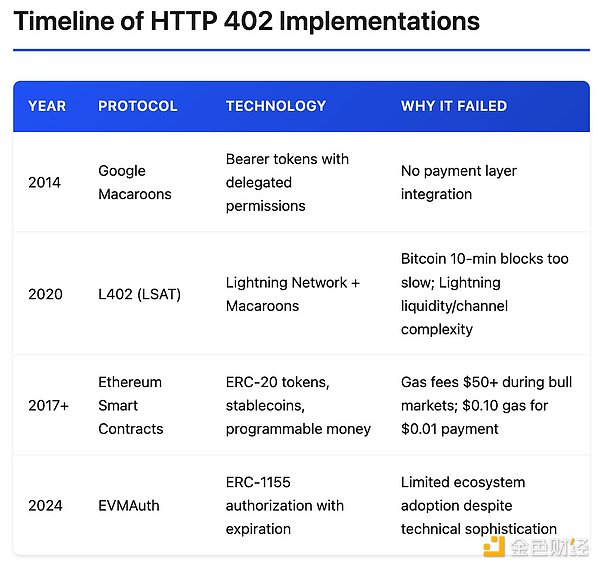
The pattern is clear: technically feasible solutions have long existed, but none have achieved the network effects necessary to become internet infrastructure. The real challenge has never been the technology itself, but rather the coordination problem—how to get enough service providers to accept payments and enough users to use them.
4x402 Protocol: Activating Dormant Payment Standards
x402 combines the HTTP 402 status code with stablecoin-based blockchain settlement. This protocol adds a lightweight payment layer while preserving existing network infrastructure. The implementation process is simple: when a client requests a resource without payment, the server returns an HTTP 402 and a structured payment request (amount, receiving address, token contract, blockchain network). The client constructs a cryptographically signed payment authorization (following the EIP-3009 standard), appends it to the retry request via the X-PAYMENT header, and the server verifies it, broadcasts the transaction, and returns the resource and transaction details.
x402Payment Process Diagram:
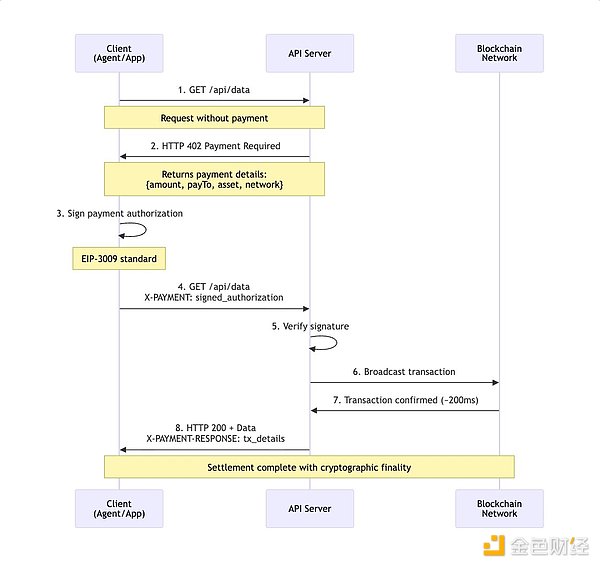
Settlement on Layer 2 networks such as Base takes approximately 200 milliseconds, with a fee of less than $0.0001. Payments are final and irreversible, confirmed by cryptography. Developers only need to add middleware configuration:
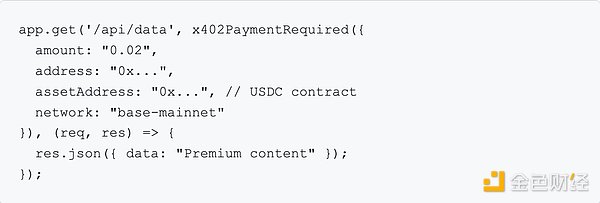
From the perspective of the intelligent agent, clients that support the x402 protocol can automatically detect 402 responses, construct payment authorization, and complete retry requests, without any manual intervention.
6Ecosystem Evolution: From Protocol to Practical Applications
Since Coinbase launched the x402 protocol, the ecosystem has developed rapidly, with over 50 projects providing infrastructure, services, and integration support:
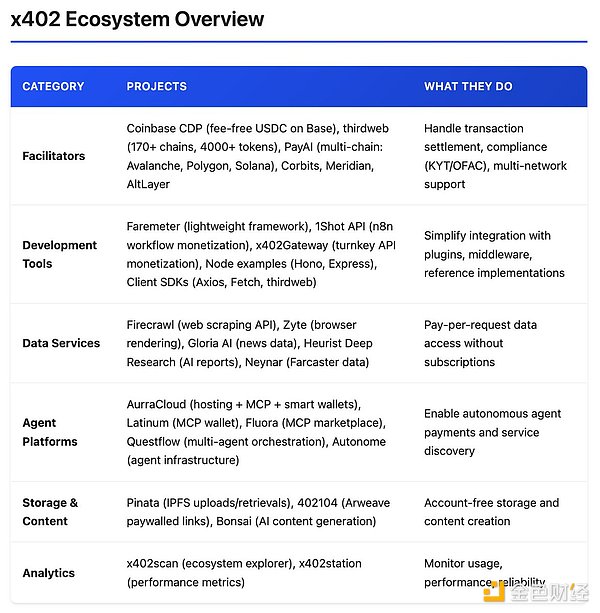
This broad coverage indicates that x402 has moved beyond the prototype stage and entered production-level deployment across multiple vertical sectors. Its common core lies in eliminating account systems, API keys, and subscription models, shifting to a pay-per-use direct access model.
7. Economic Significance and Application Scenarios Scalable micropayments enable unprecedented business models: content providers can shift to per-article billing instead of monthly subscriptions; API providers can charge per request instead of tiered packages; and data services are priced by query count instead of user seats. This granular pricing precisely aligns value creation and capture—researchers can pay $0.25 per article instead of a $200 annual fee, and AI systems can purchase computing power on demand instead of reserved instances. This model eliminates the operational pain points of traditional payments: no chargeback risk, instant settlement, reduced fraud (cryptographic authorization required), and lower compliance costs (an unalterable audit trail). For AI systems, the x402 enables true financial autonomy—automated trading algorithms can access real-time data for $0.02 per transaction, computer vision systems can purchase GPU inference at $0.005 per image, and research agents can dynamically purchase papers based on relevance.

8、x402Gateway: Protocol as a Service
While the x402 protocol is elegantly and simply designed, its implementation still requires technical investment: middleware integration, cryptographic verification, blockchain interaction management, and secure key escrow. The x402 gateway encapsulates these complexities into out-of-the-box facilities, allowing any API owner to add payment requests without modifying their existing system.

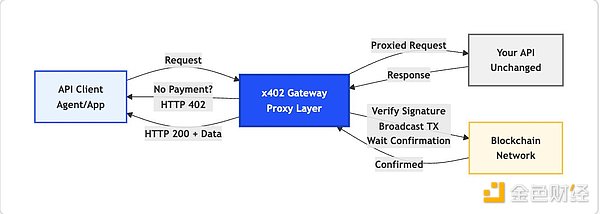
9,x402Gateway: Protocol as a Service Solution
10、Coordinating Challenges and Builder Opportunities
Payment systems are dominated by network effects: their value is only realized when most merchants accept a payment method and consumers widely use it. This "chicken and egg" problem has caused many technically sophisticated solutions (such as Macaroons and L402) to fail because they did not reach critical scale. x402 attempts to break the deadlock through a triple design: lightweight infrastructure (relying on the HTTP protocol), composability (middleware integration rather than application reconstruction), and separation of concerns (decoupling blockchain settlement from business logic).
The rise of autonomous intelligent agents has created a natural demand—AI systems need payment capabilities to operate independently. Humans may resist new payment methods, but intelligent agents must have machine-native payment mechanisms.
Enterprise support is crucial for coordination: Coinbase's endorsement represents a commitment from mainstream crypto infrastructure, while Google's A2A agreement with enterprise partners (Salesforce, SAP, and ServiceNow) demonstrates a growing industry consensus on the need for standardization of intelligent agent infrastructure. Open source features and multi-vendor implementations effectively prevent vendor lock-in. There is a significant infrastructure gap. Existing tools are mostly based on the assumption of low-frequency payments by human users, while native intelligent agent infrastructure must support high-frequency micropayments, autonomous value assessment, and machine-readable service descriptions. Those who pioneer the establishment of standards in these areas may define the infrastructure framework that will endure for decades to come.
11、A Moment of Infrastructure Transformation
As autonomous intelligent agents transform from experimental novelties into critical infrastructure, the internet is undergoing a fundamental transformation. This transformation requires a new economic primitive: advertising models that rely on attention extraction and behavioral targeting cannot survive in an "agent-first" world—because attention extraction is no longer possible, and behavioral targeting is ineffective.
x402, by activating the dormant HTTP standard (the 402 status code has been retained since the 1990s) and combining it with modern blockchain infrastructure, provides a potential foundation for a native internet payment system. Early applications in multiple fields have already shown real demand: AI inference, data services, API monetization, and content publishing. Although whether x402 will become the final standard remains uncertain, the core issues are clear and urgently need to be addressed.
The original sin of the internet is not advertising itself, but the surveillance infrastructure it relies on.
Blockchain micropayments offer a new balance: users and agents pay directly for high-value services, creators receive revenue matched to usage, and comprehensive behavioral tracking becomes economically unnecessary. The realization of this vision depends on execution efficiency, adoption scale, and network effects. But the opportunity is enormous for builders: platforms like the x402 gateway lower the implementation barrier, enabling any API or content provider to deploy agent-native payments. The current stakes are on laying the foundation for internet infrastructure for decades to come—building a unified payment layer or risking a fragmented system that fosters a new surveillance economy.
 Joy
Joy











